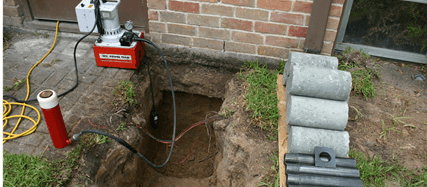Foundation Repair Oklahoma City OK: Guaranteeing Your Home's Safety and security and Value
Foundation Repair Oklahoma City OK: Guaranteeing Your Home's Safety and security and Value
Blog Article
Exploring Various Approaches of Foundation Repair Service for Numerous Soil Types
Foundation repair work is a crucial element of keeping structural honesty, particularly when thinking about the diverse challenges positioned by various soil types. The complexity of soil actions under differing conditions necessitates a tailored method to fix, making certain optimal remedies such as helical piers for unsteady dirts or chemical cements for natural layers.
Recognizing Dirt Types
Soil kinds play an important duty in the security and long life of building structures, making it important for property owners and construction experts to comprehend their attributes and habits. The interaction between soil and foundation can establish the architectural integrity of a structure. There are several dirt kinds, each with unique physical residential or commercial properties that affect exactly how structures are made and preserved.
Granular soils, such as sand and gravel, provide excellent water drainage and are often thought about steady. In contrast, cohesive dirts like clays and silts show various habits.
Rocky soils, recognized for their stamina and stability, offer superb support for structures but may call for customized tools for excavation. Conversely, loamy soils, which are a well balanced blend of sand, silt, and clay, frequently supply beneficial problems for foundation support because of their modest water drainage buildings.

Comprehending these soil types is important for selecting proper foundation repair service techniques, making sure the durability and safety of frameworks over time.
Challenges With Expansive Clay
Amongst the various dirt types, extensive clay provides distinct challenges for foundation stability due to its propensity to undertake substantial volume modifications with wetness variant. This type of soil swells when damp and agreements when dry, which can put in substantial pressure on structures. These variations can lead to foundation fracturing, heaving, and negotiation concerns, presenting substantial risks to the structural stability of buildings.
The difficulties with large clay are worsened by its plasticity index, which measures the soil's ability to change shape and quantity. A high plasticity index indicates greater potential for motion, enhancing the probability of damages to foundations. This is especially troublesome in areas experiencing severe or regular climate adjustments, where cycles of wet and dry conditions are common.
Moreover, the depth of expansive clay layers can vary, complicating the analysis and preparation of suitable structure repair service techniques. These intricacies need a comprehensive geotechnical examination to ensure reliable structure repair methods are implemented, stressing the significance of dealing with extensive clay obstacles with proficiency and care.
Solutions for Sandy Soils
Sandy dirts, characterized by their large particle dimension and low communication, existing unique difficulties for foundation security due to their propensity for moving and erosion. By anchoring the structure to much deeper, a lot more steady soil layers, these systems can supply the essential assistance to combat the moving nature of sandy soils.
Another suggested approach is the application of dirt stablizing methods. Chemical grouting, for example, entails infusing a stabilizing agent into the soil, which improves communication and lowers permeability. This process helps to solidify the sandy substrate, consequently decreasing the threat of erosion and activity.
Additionally, installing correct drainage systems is vital in sandy soil conditions. Ensuring appropriate drainage can avoid water build-up around the foundation, which frequently intensifies disintegration and soil displacement. Techniques such as French drains pipes or surface area grading can be utilized to guide water far from the building perimeter.
Resolving Working Out in Loamy Soils
Loamy soils, understood for their well balanced mix of silt, sand, and clay, provide a fertile base for numerous structures however can often cause foundation settling due to their unique make-up. This well balanced texture supplies superb water drainage and nutrient retention, making it ideal for agriculture and landscaping. Nevertheless, this same attribute can become problematic for foundations, as changes in dampness material can cause the soil to increase or contract, leading to settling.
Dealing with settling in fertile soils calls for a complex technique. At first, exact soil screening is critical to identify the certain composition and dampness web content of the loam. When information is gathered, carrying out proper drainage remedies is important to maintain constant moisture levels, thus minimizing the risk of dirt tightening or development. French drains or surface grading are efficient techniques to reroute water away from the structure.

Cutting-edge Repair Service Methods
In the realm of structure repair, cutting-edge techniques are continuously being established to resolve the facility tests postured by various dirt problems. As dirt types vary dramatically in their structural residential properties, traditional approaches might not always are enough. The introduction of brand-new innovations in structure repair work supplies more tailored solutions, making sure security and durability.
One noteworthy advancement is making use of helical piers, which are especially article source efficient in expansive or unstable soils (foundation repair Oklahoma). These piers are screwed right into the ground up until they reach a stable layer of soil, supplying strong assistance for the structure over. This approach reduces disruption and is versatile to various dirt types, making it a functional solution
An additional cutting-edge technique is the application of polyurethane foam shot. This approach entails injecting high-density polyurethane foam beneath the foundation to fill gaps and maintain the structure. It is a much less invasive choice to conventional base, using fast setup with minimal disruption to the surrounding location.
In addition, dirt stablizing this website methods, such as making use of chemical grouts, have actually acquired grip. These substances improve soil strength and decrease leaks in the structure, preventing future shifting. Jointly, these ingenious repair methods provide reliable services for the diverse challenges posed by differing soil problems.
Conclusion

Structure repair work is a critical aspect of maintaining structural stability, especially when considering the diverse obstacles posed by various soil kinds (foundation repair oklahoma city). The complexity of dirt habits under differing conditions demands a customized method to fix, guaranteeing optimum services such as helical piers for unsteady soils or chemical cements for cohesive layers. By securing the structure to deeper, much more steady soil layers, these systems can supply the necessary support to counteract the moving nature of sandy soils
Structure fixing calls for cautious consideration of dirt types to ensure stability and durability. Chemical grouts improve soil stamina and lower leaks in the structure in cohesive dirts.
Report this page